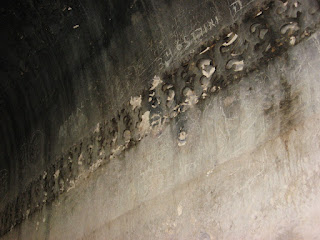I have found that sometimes it is not what you know, but who you know that will get you places in this world. Sherry was in charge of the lab on our site, and she processed everything we found on the site, whether it was a large mortar stone, or a small shurd of pottery. Not only was she fantastic in the lab, and had a wealth of knowledge at her disposal, she is one of the nicest people I have ever had the fortune of knowing.
When we visited Maresha we had the pleasure of having Sherry take us on a tour of the site. Maybe that is what helped add to the appeal of the site, the personal connection I had because I was given a tour by someone who was passionate about the place, who dedicated years to excavating there, who loved learning about it, and who shared that passion with all of us.
In addition to seeing the main part of Maresha, Sherry also took us to visit a place dubbed the Horse Cave. This cave held a special meaning to Sherry, who overlooked the excavations that went on in the cave, and who wrote her graduate thesis about the cave.
Although called the horse cave, Sherry’s argument was it was a place of worship for those who were part of the religion Mithraism, a growing religion at the turn of the century. Mithraism should ring a bell, because I mentioned it in my winter solstice post; I think it was interesting for me to see it pop up there, after touching the surface of the religion when Sherry showed us her cave.
That got me thinking about what the religion actually involved. It was limited to men, and during the Roman rule it spread to, first to the men in the army, than to others in the Roman Empire.
As previously stated, Mithraism derives from the Persian religion Zoroastrianism. (I honestly have no idea how Zoroastrianism works, but one of my professors compared it to Lord of the Rings, with good and evil influences... take that description as you will.) Mithraism is a religion dedicated to Mithra, God of light and wisdom for Romans, and contracts and oaths for Persians. The slaying of a bull is also central to Mithra.
Mithraism rapidly spread through the Roman Empire during the Second Century C.E. About 400 different sites have been found across the empire, extending from Turkey to Britain, most concentrated in Rome.
The religion is one of contracts and loyalty between men. There were no known women followers, and the religion was immensely popular. Members met in small caves for worship. While not all were caves, these temples were dug into the earth, and lacked exterior decoration. A communal meal was important to the religion, with all caves finding evidence of large dining quarters. There was an initiation into seven successive levels of the religion, some including ablutions (baptism), purifications and ceremonial passwords. A simulated death and resurrection was probably part of the ceremony. The levels were:
Raven (Murcury)
Nymphus (Venus)
Soldier (Mars)
Lion (Jupiter)
Persian (Moon)
Heliodromus (Sun)
Father (Saturn)
There are several similarities between Mithraism and Christianity, one being the celebration of Christmas on December 25. The idea of resurrection is also central to Mithraism.
Having Sherry there to give background on the site really made it one of my favorites to visit. Even now, thinking back to the site I still think fondly of that day, and having Sherry as our tour guide.
My camera died (shock!) so thanks to Kendra Day for the photos. Not as good as I would have liked, but you can see a bit of this temple and some of the structures there.
Subscribe to:
Post Comments (Atom)





Nice photos. I recall reading that the reason Christmas Day is on the 25th is because the Emperor was hedging his bets between Mithraism and Christianity.
ReplyDelete